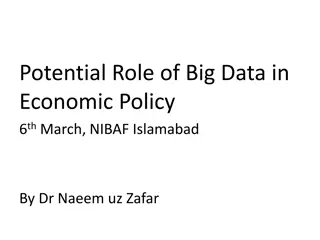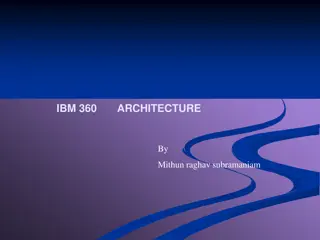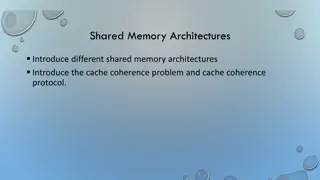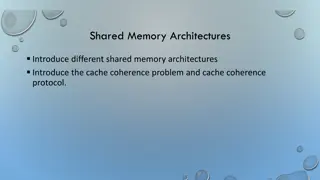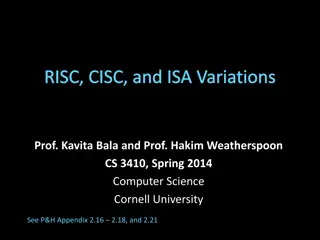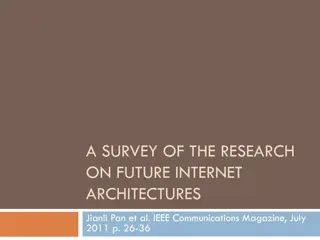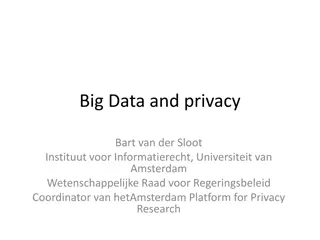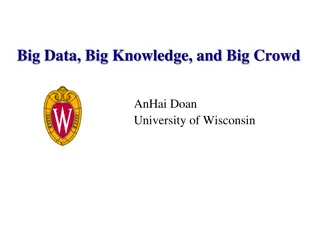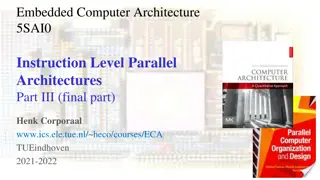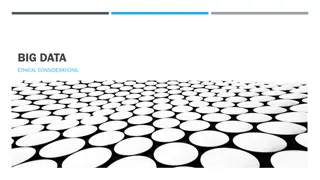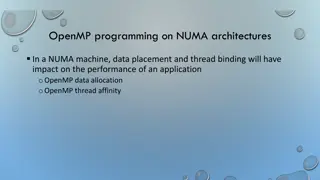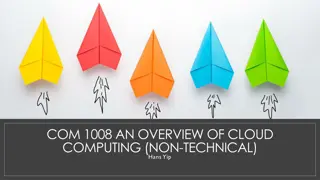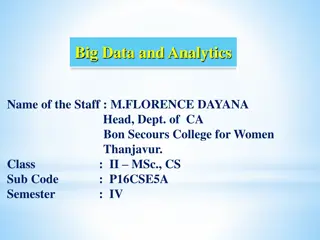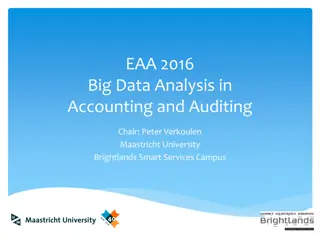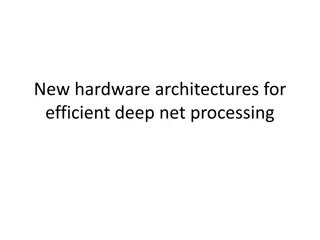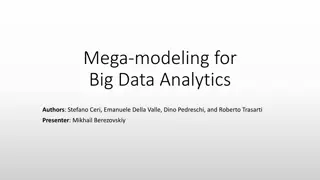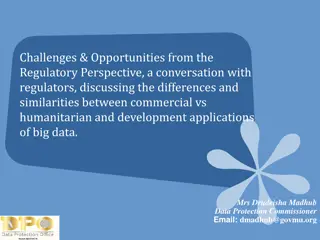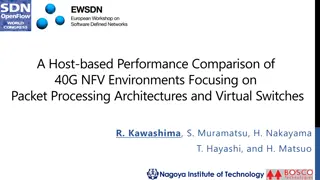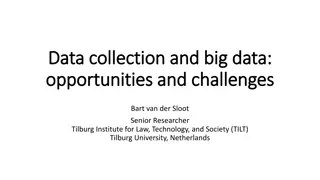Big Data Applications and Architectures Overview
Detailed use cases covering various industries like government operations, healthcare, deep learning, and more. Learn about mini-applications for benchmarking computers and software in parallel computing. Discover the evolving landscape of benchmarking in the context of cloud and data-intensive applications.
Download Presentation

Please find below an Image/Link to download the presentation.
The content on the website is provided AS IS for your information and personal use only. It may not be sold, licensed, or shared on other websites without obtaining consent from the author.If you encounter any issues during the download, it is possible that the publisher has removed the file from their server.
You are allowed to download the files provided on this website for personal or commercial use, subject to the condition that they are used lawfully. All files are the property of their respective owners.
The content on the website is provided AS IS for your information and personal use only. It may not be sold, licensed, or shared on other websites without obtaining consent from the author.
E N D
Presentation Transcript
Understanding Big Data Applications and Architectures 1st JTC 1 SGBD Meeting SDSC San Diego March 19 2014 Geoffrey Fox Judy Qiu Shantenu Jha (Rutgers) gcf@indiana.edu http://www.infomall.org School of Informatics and Computing Digital Science Center Indiana University Bloomington
51 Detailed Use Cases: Contributed July-September 2013 Covers goals, data features such as 3 V s, software, hardware 26 Features for each use case http://bigdatawg.nist.gov/usecases.php https://bigdatacoursespring2014.appspot.com/course (Section 5) Government Operation(4): National Archives and Records Administration, Census Bureau Commercial(8): Finance in Cloud, Cloud Backup, Mendeley (Citations), Netflix, Web Search, Digital Materials, Cargo shipping (as in UPS) Defense(3): Sensors, Image surveillance, Situation Assessment Healthcare and Life Sciences(10): Medical records, Graph and Probabilistic analysis, Pathology, Bioimaging, Genomics, Epidemiology, People Activity models, Biodiversity Deep Learning and Social Media(6): Driving Car, Geolocate images/cameras, Twitter, Crowd Sourcing, Network Science, NIST benchmark datasets The Ecosystem for Research(4): Metadata, Collaboration, Language Translation, Light source experiments Astronomy and Physics(5): Sky Surveys including comparison to simulation, Large Hadron Collider at CERN, Belle Accelerator II in Japan Earth, Environmental and Polar Science(10): Radar Scattering in Atmosphere, Earthquake, Ocean, Earth Observation, Ice sheet Radar scattering, Earth radar mapping, Climate simulation datasets, Atmospheric turbulence identification, Subsurface Biogeochemistry (microbes to watersheds), AmeriFlux and FLUXNET gas sensors Energy(1): Smart grid 2
Would like to capture essence of these use cases small kernels, mini-apps Or Classify applications into patterns Do it from HPC background not database view point i.e. focus on cases with detailed analytics
What are mini-Applications Use for benchmarks of computers and software (is my parallel compiler any good?) In parallel computing, this is well established Linpack for measuring performance to rank machines in Top500 (changing?) NAS Parallel Benchmarks (originally a pencil and paper specification to allow optimal implementations; then MPI library) Other specialized Benchmark sets keep changing and used to guide procurements Last 2 NSF hardware solicitations had NO preset benchmarks perhaps as no agreement on key applications for clouds and data intensive applications Berkeley dwarfs capture different structures that any approach to parallel computing must address Templates used to capture parallel computing patterns I ll let experts comment on database benchmarks like TPC
HPC Benchmark Classics Linpack or HPL: Parallel LU factorization for solution of linear equations NPB version 1: Mainly classic HPC solver kernels MG: Multigrid CG: Conjugate Gradient FT: Fast Fourier Transform IS: Integer sort EP: Embarrassingly Parallel BT: Block Tridiagonal SP: Scalar Pentadiagonal LU: Lower-Upper symmetric Gauss Seidel
7 Original Berkeley Dwarfs (Colella) 1. Structured Grids (including locally structured grids, e.g. Adaptive Mesh Refinement) 2. Unstructured Grids 3. Fast Fourier Transform 4. Dense Linear Algebra 5. Sparse Linear Algebra 6. Particles 7. Monte Carlo 8. Note vaguer than NPB
13 Berkeley Dwarfs Dense Linear Algebra Sparse Linear Algebra Spectral Methods N-Body Methods Structured Grids Unstructured Grids MapReduce Combinational Logic Graph Traversal Dynamic Programming Backtrack and Branch-and-Bound Graphical Models Finite State Machines First 6 of these correspond to Colella s original. Monte Carlo dropped N-body methods are a subset of Particle Note a little inconsistent in that MapReduce is a programming model and spectral method is a numerical method Need multiple facets!
Distributed Computing MetaPatterns I Jha, Cole, Katz, Parashar, Rana, Weissman
Distributed Computing MetaPatterns II Jha, Cole, Katz, Parashar, Rana, Weissman
Distributed Computing MetaPatterns III Jha, Cole, Katz, Parashar, Rana, Weissman
Problem Architecture Facet of Ogres (Meta or MacroPattern) i. Pleasingly Parallel as in Blast, Protein docking, some (bio-)imagery ii. Local Analytics or Machine Learning ML or filtering pleasingly parallel as in bio-imagery, radar images (really just pleasingly parallel but sophisticated local analytics) iii. Global Analytics or Machine Learning seen in LDA, Clustering etc. with parallel ML over nodes of system iv. SPMD (Single Program Multiple Data) v. Bulk Synchronous Processing: well defined compute- communication phases vi. Fusion: Knowledge discovery often involves fusion of multiple methods. vii. Workflow (often used in fusion)
Core Analytics Facet of Ogres (microPattern) Search/Query Local Machine Learning pleasingly parallel iii. Summarizing statistics iv. Recommender Systems (Collaborative Filtering) v. Outlier Detection (iORCA) vi. Clustering (many methods), vii. LDA (Latent Dirichlet Allocation) or variants like PLSI (Probabilistic Latent Semantic Indexing), viii. SVM and Linear Classifiers (Bayes, Random Forests), ix. PageRank, (Find leading eigenvector of sparse matrix) x. SVD (Singular Value Decomposition), xi. Learning Neural Networks (Deep Learning), xii. MDS (Multidimensional Scaling), xiii. Graph Structure Algorithms (seen in search of RDF Triple stores), xiv. Network Dynamics - Graph simulation Algorithms (epidemiology) i. ii. Global Optimization Matrix Algebra
Analytics Features Facet of Ogres These core analytics/kernels can be classified by features like (a) Flops per byte; (b) Communication Interconnect requirements; (c) Is application (graph) constant or dynamic (d) Is communication BSP or Asynchronous (e) Are algorithms Iterative or not? (f) Are data points in metric or non-metric spaces
Application Class Facet of Ogres (a) Search and query (b) Maximum Likelihood, (c) 2minimizations, (d) Expectation Maximization (often Steepest descent) (e) Global Optimization (Variational Bayes) (f) Agents, as in epidemiology (swarm approaches) (g) GIS (Geographical Information Systems).
Data Source Facet of Ogres (i) SQL, (ii) NOSQL based, (iii) Other Enterprise data systems (10 examples from Bob Marcus) (iv) Set of Files (as managed in iRODS), (v) Internet of Things, (vi) Streaming and (vii) HPC simulations. Before data gets to compute system, there is often an initial data gathering phase which is characterized by a block size and timing. Block size varies from month (Remote Sensing, Seismic) to day (genomic) to seconds or lower (Real time control, streaming) There are storage/compute system styles: Shared, Dedicated, Permanent, Transient Other characteristics are need for permanent auxiliary/comparison datasets and these could be interdisciplinary implying nontrivial data movement/replication
Lessons / Insights Ogres classify Big Data applications by multiple facets each with several exemplars and features Guide to breadth and depth of Big Data Does your architecture/software support all the ogres? Add database exemplars In parallel computing, the simple analytic kernels dominate mindshare even though agreed limited Section 5 of my class https://bigdatacoursespring2014.appspot.com/preview classifies 51 use cases with these facets



